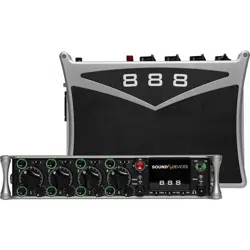Loading ...
Loading ...
Loading ...

888 User Guide
44
Post-roll
An extra period of time that is appended to the end of a recording
when stop is pressed. If record is pressed during this period of
time, recording will resume within the same le with no audio lost.
This is particularly useful should a Director call ‘cut’ prematurely or
accidentally.
Project
An option available for le organization on Sound Devices recorders.
Projects are the highest level of le folder organization. The project
folder can contain sub-folders of scene les or recorded les directly.
Record bell
A tone generated in headphones to alert the listener that recording
has started. The bell is also produced when recording has ended with
the stop button, when the recording volume is full, or when power is in
a critical state.
Sampling rate
When converting between analog and PCM digital audio the analog
signal is measured (sampled) in unique steps at a data rate specied
in kHz. Higher sampling rates allow for representing higher frequency
analog audio. 48 kHz is the standard sampling rate for production,
worldwide. Higher sampling rates including 96 kHz and 192 kHz are
used for high-precision applications where the representation of audio
above 20 kHz is required. A general rule is that the maximum analog
audio frequency is ½ the sampling rate.
Scene
On Sound Devices recorders the scene becomes part of the le
name for a take. Scene names can be pre-loaded to quickly change
between scenes.
Slate microphone
A microphone, built-in or external microphone, on an audio mixer used
to notate takes or communicate with sound team members by the
mixer’s user speaking into the microphone. Slate microphones are
often routable to buses or tracks.
Stereo linking (inputs)
When active for stereo sources such as stereo microphones, linked
inputs are hard panned to the left and right bus. Controls including
gain (trim), fader, high pass lter, delay, limiter, mute, and routing are
controlled together.
Sticky Notes
Notes that persist to subsequent takes.
Solo
A control on a mixer to route a channel to headphones while muting
all others. Solo and PFL are related controls and in many consoles are
the same. Solo circuits can be exclusive—only one channel is sent to
headphones at a time—or non-exclusive—any number of channels can
be sent to the solo circuit and appear in headphones.
TA-type connector (TA3, TA4, TA5, TA6)
Miniature XLR-type, locking connectors. TA3 connectors are used
by Sound Devices for various inputs, outputs, and as balanced and
unbalanced connections. TA4 connectors are used by Sound Devices
for DC power connections to the 888 mixer-recorder. TA4 is also used
for audio connections from lavalier microphones to some wireless
transmitters. Ta5 connectors are used for Mic/Line inputs and the
headset on the 888. TA6 connectors are presently not used by
Sound Devices though they are used for audio connections by other
manufacturers.
Take
A recorded take is an individual recorded le (or les when recording
monophonic WAV les) generated by a recorder. Take numbers are
auto-incrementing. Take numbers are added to the end of the le
name.
Take list
Separate from a le list, a take list consolidates related les such
as a group of monophonic WAV les generated by a single take and
presents them as a single take.
Test tone
See tone oscillator.
Timecode
A numerical clock value expressed in hours:minutes:seconds:frames,
i.e. 04:59:39:05, used to synchronize cameras, video decks,
and audio recorders. Timecode requires clocks on devices to be
synchronized, either through a wired or wireless connection between
devices, or through a process called “jam sync” where each device,
which requires a high-precision clock, runs independently after their
clocks are synchronized.
Timecode mode
Sound Devices recorders offer multiple timecode modes. Different
modes correspond to different timecode workows. Common modes
available in Sound Devices recorders include:
Record run - timecode advances only when recording is engaged.
Free run - timecode run continuously, typically with the start of
production being at 0 hour.
24 hour - similar to free run except the start time corresponds to time-
of-day.
Ext TC - the recorder applies the value of an external timecode source.
Tone oscillator
A sound generator producing a sine wave tone at a given frequency at
a given output level. With its known output level tone oscillators are
helpful to set gain structure between audio equipment.
Track
A single recorded audio signal. Common recorded tracks are the main
left/right master audio bus and isolated (ISO) channel recordings. ISO
tracks are typically identied by the channel of the same number, e.g.
channel 1 is sent to track 1, channel 2 is sent to track 2, etc.
Track arm
Tracks that are active and ready for recording are said to be “armed”.
When recording begins all armed tracks begin recording. Depending
on the production is may be advantageous to arm and disarm tracks,
especially to disarm unused tracks.
Track name
Individual tracks of a multi-track recording can be named to indicate
microphone type or character name.
Trim
Also dened in mixers as “gain”, the trim adjustment is the rst
stage of gain of a microphone or line level input. Typical microphone
trim values range from 10 dB to 50 dB, depending on microphone
sensitivity and volume of the sound source.
Loading ...
Loading ...
Loading ...
